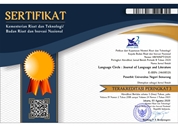Communication Strategies in English Second Language Acquisition
(1) Universitas Negeri Semarang, Indonesia
Abstract
This research aims to describe and analyze communication strategies used by learners in the acquisition of a second language. In this case, this research analyzes the use of communication strategies in which English is the language of instruction.This study involved 21 students at the Department of English Language and Literature, in one of the state universities in Semarang, Indonesia. These students are second year students in the English Language and Literature Department. This research is a case study in the purpose of investigating the communication strategies used when the participants are engaged when the learning activities take place. The participants are given a conversation project in pairs and exposed to a variety of setting such as in the restaurant, in the professor’s room, and in a company. Data collection was carried out through video and audio recordings. The data obtained are then categorized into 13 categories of communication strategies (Dornyei, 1995) and sorted to obtain the frequency of occurrence. The findings indicate that the students mostly use time-gaining strategy (36%) to overcome the problem in their communication with the interlocutors. It is then followed by the use of meaningless words which occurs very frequently (18%) from all utterances, “repetition†strategy which occurs rather frequently about 16% of the total, literal translation (13%), and “use of non-linguistics means†(10%). In conclusion, choices of communication strategies are highly influenced by the level of the conversation tasks given (Wongsawang, 2001). The occurrence of certain types of communication strategies depends on the tasks given to the students and the level of difficulty of those tasks.
Keywords
case study; communication strategies; second language acquisition
Full Text:
PDFRefbacks
- There are currently no refbacks.

This work is licensed under a Creative Commons Attribution 4.0 International License

